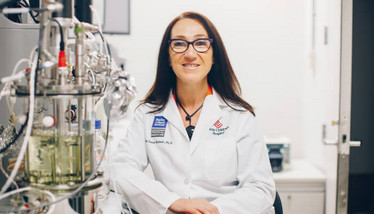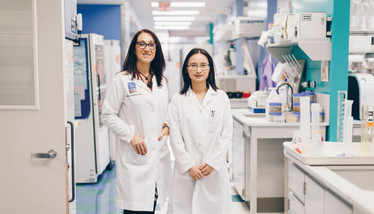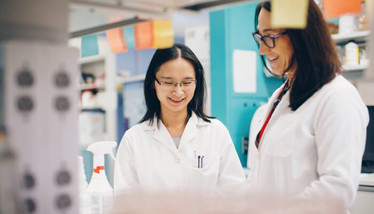
Lending a Helping Hand
Maria Elena Bottazzi, Co-Director at the Texas Children’s Hospital Center for Vaccine Development at Baylor College of Medicine, and Bart Fryszczyn, a process development scientist at Merck, tell a tale of academia and industry – and how collaborations are essential to help the world’s poorest, who face some of the worst diseases.
Maria Elena Bottazzi, Bart Fryszczyn | | Longer Read

Schistosomiasis is a tropical infection primarily caused by parasitic worms. The mortality rate is low, but it affects millions of people (mainly in the poorest populations in the world) and causes huge burdens of morbidity. It is difficult to diagnose because there are often few symptoms early on, but over time the worm causes damage to the bladder, kidneys and liver, causing malnutrition, inflammation and pain. It affects people of all ages, including children, and for women and can cause complications with pregnancy. The estimated number of people infected is around 250 million. In some African countries, studies estimate that half of the population is infected.
Maria Elena Bottazzi, Co-Director at the Texas Children’s Hospital Center for Vaccine Development at Baylor College of Medicine, has been working to develop a vaccine for the disease. “I grew up in Honduras, which does have a burden of neglected tropical diseases. I obtained a degree in microbiology and clinical chemistry, but it was parasitology that interested me the most. When I did my PhD in the US, I focused on molecular biology, vaccines and other types of technologies to tackle parasitic diseases. For the last three decades, I’ve been working to develop global health technologies, with a strong focus on vaccines for various diseases, including schistosomiasis.”
Very few for-profit entities have any focus on neglected tropical diseases. The Center for Vaccine Development aims to develop important interventions that no one else is focusing on, including hookworm, schistosomiasis, leishmaniasis, onchocerciasis, Chagas disease, and ascariasis – to name just a few.
“When we started our vaccine program almost two decades ago, we evaluated the diseases we should be working on and schistosomiasis came out as one of our top priorities,” says Bertozzi. “There is a drug that can treat schistosomiasis (Pariquantel), but it does not prevent a person from being reinfected. We need an integrated approach because drug treatment alone is not enough. We need a vaccine.”

The manufacturing conundrum
Progress on the development of a vaccine has been going well. Bertozzi and colleagues developed a bench-scale process to develop the vaccine and take it to early clinical trials, but when it came to GMP manufacturing there were clear challenges. In particular, the process they had developed had low recovery rates, long processing times, and involved multiple unit operations. A large membrane area was also needed to ensure sufficient clarification of the fermentation broth with its relatively high viscosity and suspended solids content. To improve the process, the center has been working with Merck to streamline and design the manufacturing process for their vaccine.
“The story behind my involvement in this project is not as nice as Maria’s!” says Bart Fryszczyn, a process development scientist at Merck. “My education background lies in protein science (incidentally, I did my graduate work at the Baylor College of Medicine), but when I finished my PhD studies, I was really excited by the idea of going into industry and helping to design manufacturing processes for biologics, vaccines and other molecules. Today, I work with Merck in their technology management division. The purpose of this division is to drive the adoption of the company’s products. This may sound selfish, but the organization is made up of over a hundred engineers and scientists globally, so collectively we have a lot expertise in manufacturing outside of our products to give! We’ve worked with vaccines for decades.”
As well as working with many for-profit companies, Merck also gets involved with smaller projects targeting huge needs, such as projects involving treatments or vaccines for neglected diseases, which are also supported by Merck’s MLabs collaboration centers. “These centers help promote projects and offer a space where process development can take place using some of the latest technologies – which may not be available in other research labs,” says Fryszczyn.
The Center for Vaccine Development has been collaborating with Merck since 2017 – and Merck, itself, has a keen interest in schistosomiasis. In 2019, as part of its Pediatric Praziquantel Consortium project, Merck Healthcare initiated a Phase III clinical trial in Kenya for a new formulation of praziquantel to treat schistosomiasis in pre-school age children under the age of 6 years. The trial will also be conducted in Ivory Coast.
“Praziquantel, which is used to treat schistosomiasis, has been donated by Merck for years,” says Bertozzi. “After meeting Udit Batra, the CEO of the life science business of Merck, he put us in touch with the wider Merck network to assist with our vaccine work.”
Bertozzi’s group had three aims in mind for the collaboration:
- Shape the collaboration in a way that raises awareness of the importance of new interventions for the disease and demonstrate the benefits of collaborations between a for-profit and non-profit.
- Develop a global technology that is affordable and accessible to the different countries that need it.
- Take advantage of new innovations, such as new resins and products, and apply them to the manufacturing process.
For any vaccine or new treatment to be successful, the manufacturing process must be scalable, transferable and economically feasible. “At the onset of the collaboration, we reviewed the purification process for the molecule,” says Fryszczyn. “This is the most important aspect of manufacturing because any biologic will always have impurities. This particular vaccine was being made using yeast fermentation. Although the group had a process that worked at the bench-scale, a lot of aspects could not be implemented at a full-scale manufacturing level effectively. We identified the “low-hanging fruit” – the weakest parts of the process where we could have a high impact. One of the main areas was clarification and concentration of the molecule. The process was barely efficient and time consuming, but we redesigned it using a continuous process to make it faster with less expenditure.”
“As well as an intellectual evaluation and redesign on paper, we tested some new technologies for clarification,” adds Bertozzi. “We were able to increase the recovery rate to 42 percent. We were also able to reduce the timings and reduce process costs by 36 percent – and the process is more reliable too.”
The vaccine has gone through a first-in-human study, which was supported by the US National Institute of Health. Approval has also been received from NIH to transition to normal volunteers (those living in endemic populations) and a study has been conducted in Brazil. “We have a very nice safety profile of this vaccine candidate,” says Bertozzi. “And we have also been working with the Department of Defense of the US – because schistosomiasis not only affects populations living in endemic areas, but also areas where the US army is deployed. With the department of defence, we have now transitioned this molecule to being evaluated in populations in Africa. We’re also working with George Washington University on other areas of clinical development.”
The business of compassion
With the improved manufacturing process, Bertozzi is hopeful the team can receive funding to re-engage manufacturing companies to scale up and perform a change control. The group will need to highlight to regulators that the new process creates material that is equal to the old process that was used in clinical studies and that it maintains its attributes and characteristics. From there, they can progress into more advanced clinical and manufacturing development stages.
But a non-profit institute cannot bring a vaccine all the way through the clinic. The Center will need help from manufacturers in the areas where this disease is endemic, such as Brazil, China, India and Africa.
“It is difficult to find the right partners who are passionate about the cause,” says Bertozzi. “With neglected tropical diseases, you don’t just need high scientific input; you also require a high financial input. And this is where the industry still hasn’t deciphered what is the right business model for vaccines for neglected diseases. Someone has to contribute and I think it has to be a combination of government, for-profit entities, and non-profit entities. We are working hard on this vaccine and eventually someone somewhere is going to have to pay and help us with it.”

Fryszczyn adds that the cost of altruistic work is one of the hardest things to reconcile in the industry. For-profit companies perform work that can be described as for the greater good since it relates to health and wellbeing, but profits must also be considered. “I believe there should be more of a push for projects where profit is not a motivation,” he says. “There should be more programs between governments and for-profit entities that allow commercial companies to help academia or small institutes to develop much-needed drugs for neglected areas. The burden of developing treatments for the world’s poorest can’t be on the back of a single organization. There needs to be more incentives that help for-profit companies to get involved.”
In a traditional business model, a vaccine is made and a company will evaluate how much it costs, how much it can be sold for and what the revenues will be – and this revenue is easily quantified. However, it can be more complicated when you look at the value resulting from improved human health. “If you can prevent X number of people from becoming sick, they will have better health and can ultimately be more economically productive,” says Bertozzi. “We are very interested in metrics around public health. In collaboration with Merck, we’ve built a business case and a value proposition for the schistosomiasis vaccine, but we also need to work with policy makers in terms of how this type of vaccine will be used in a vaccine delivery strategy. There is a huge problem with vaccine hesitancy right now and nobody wants to develop a vaccine that people will not accept and use. This is an issue all of connected with drug development or global health have a duty to contribute to.”
Musing on Academia’s Changing Times
By Maria Elena Bottazzi
There is a view that academics don’t have a lot of interaction with biotechnology or pharma entities, but academia is beginning to play a much more important role in the drug development ecosystem by helping to translate basic research to real products. This is because the nature of how the industry develops treatments is changing – with many pharmaceutical entities wanting to collaborate more with academic institutes to jointly develop global health technology.
But this brings challenges. Our Texas Children’s Hospital Center for Vaccine Development has more than two decades in operation, but how do we shift from an academic mentality to becoming an almost pseudo-biotech company when we are a non-profit developing products that will never make money? We’ve had to develop new infrastructure, including regulatory support, more PhD students, and new scientific staff and investigators who can drive hypotheses and conduct academic work (which includes lecturing and teaching), but also have the mindset to develop serious products that can one day be licensed.
It can be a wonderful world to work in. One of the things I love about my job is that it spans both worlds. I am a professor, but I have the opportunity of navigating the biotechnology sphere and collaborating with industry to really move our products forward. At times, it’s as if I was embedded in a big pharmaceutical company.
At our Center for Vaccine Development, we do basic science, but we can also perform translational research, develop products, and perform manufacturing and technology transfer. We collaborate with partners for regulated studies and submit our own regulatory applications. It’s only through change and collaboration that we can really deliver these much-needed interventions for neglected tropical diseases.



















